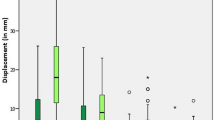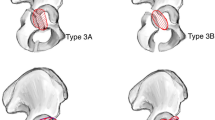Abstract
Purpose
Acetabular fractures are associated to an increased risk of subsequent hip osteoarthritis. The only available score for post-operative reduction assessment in acetabular fractures (Matta’s score) is x-ray based. CT-scan was shown superior to X-rays in post-operative reduction assessment. We aim to describe a CT-scan-based post-operative reduction score in acetabular fractures and evaluate its accuracy and reproducibility.
Methods
This is a retrospective study that includes 138 patients who underwent surgery for an acetabular fracture in our tertiary referral centre with a mean follow-up of 104.39±42.2 months. The post-operative CT-scan was reviewed and residual displacement (maximum gap and step) measured by three independent observers. The association between the occurrence of THA and the CT-scan measurements was evaluated. This led to a new prognostic score. The interobserver reliability and accuracy of this score were calculated.
Results
Interobserver reproducibility for the residual maximal gap was 0.82 (95% CI [0.70–0.89]) and 0.61 (95% CI [0.52–0.70]) for the residual maximal step displacement measurements. We created a score from a logistic regression model, attributing 1 point for every 1 mm of residual maximal step displacement and 1 point for every 2 mm of residual maximal gap displacement. The interobserver reproducibility of this score was 0.78 (95% CI [0.71–0.84]), and its AUC was 0.79 (95% CI [0.69–0.88]).
Conclusion
This is the first CT-scan-based score for the assessment of residual displacement of a surgically treated acetabular fracture. It shows good interobserver reproducibility and accuracy in predicting the risk for secondary THA. It should be regularly used per-operatively (if per-operative 3D imaging is available) and post-operatively to predict the prognosis.





Similar content being viewed by others
Data Availability
Data and material are available.
References
Court-Brown CM, Caesar B (2006) Epidemiology of adult fractures: a review. Injury 37(8):691–697. https://doi.org/10.1016/j.injury.2006.04.130
Ragnarsson B, Jacobsson B (1992) Epidemiology of pelvic fractures in a Swedish county. Acta Orthop Scand 63(3):297–300. https://doi.org/10.3109/17453679209154786
Melhem E, Riouallon G, Habboubi K et al (2020) Epidemiology of pelvic and acetabular fractures in France. Orthop Traumatol Surg Res 106(5):831–839. https://doi.org/10.1016/j.otsr.2019.11.019
Chung TC, Chen TS, Hsu YC et al (2020) Long-term total hip arthroplasty rates in patients with acetabular and pelvic fractures after surgery: a population-based cohort study. PloS One 15(4):e0231092. https://doi.org/10.1371/journal.pone.0231092
Matta JM (1996) Fractures of the acetabulum: accuracy of reduction and clinical results in patients managed operatively within three weeks after the injury. J Bone Joint Surg Am 78(11):1632–1645. https://doi.org/10.2106/00004623-199611000-00002
Briffa N, Pearce R, Hill AM et al (2011) Outcomes of acetabular fracture fixation with ten years’ follow-up. J Bone Joint Surg Br 93(2):229–236. https://doi.org/10.1302/0301-620X.93B2.24056
Tannast M, Najibi S, Matta JM (2012) Two to twenty-year survivorship of the hip in 810 patients with operatively treated acetabular fractures. J Bone Joint Surg Am 94(17):1559–1567. https://doi.org/10.2106/JBJS.K.00444
Matta JM, Mehne DK, Roffi R (1986) Fractures of the acetabulum. Early results of a prospective study. Clin Orthop Relat Res 205:241–250. https://doi.org/10.1097/00003086-198604000-00030
Verbeek DO, Van Der List JP, Moloney GB et al (2018) Assessing postoperative reduction after acetabular fracture surgery: a standardized digital computed tomography-based method. J Orthop Trauma 32(7):E284–E288. https://doi.org/10.1097/BOT.0000000000001161
Verbeek DO, Van Der List JP, Villa JC et al (2017) Postoperative CT is superior for acetabular fracture reduction assessment and reliably predicts hip survivorship. J Bone Joint Surg Am 99(20):1745–1752. https://doi.org/10.2106/JBJS.16.01446
Moed BR, Willson Carr SE, Gruson KI et al (2003) Computed tomographic assessment of fractures of the posterior wall of the acetabulum after operative treatment. J Bone Joint Surg Am 85(3):512–522. https://doi.org/10.2106/00004623-200303000-00018
Borrelli JJ, Ricci WM, Steger-May K et al (2005) Postoperative radiographic assessment of acetabular fractures: a comparison of plain radiographs and CT scans. J Orthop Trauma 19(5):299–304. https://doi.org/10.1097/01.bot.0000157910.38315.0d
Elnahal WA, Ward AJ, Acharya MR et al (2019) Does routine postoperative computerized tomography after acetabular fracture fixation affect management? J Orthop Trauma 33(Suppl 2):S43–S48. https://doi.org/10.1097/BOT.0000000000001405
Kiran M, Frostick R, Elnahal W, Spence D, Acharya M, Ward A, Chesser TJS (2022) The fate of acetabular fracture fixation at 10 years: rates of conversion to arthroplasty. Hip Int 17:11207000221138040. https://doi.org/10.1177/11207000221138040 Epub ahead of print
Cichos KH, Spitler CA, Quade JH et al (2021) Fracture and patient characteristics associated with early conversion total hip arthroplasty after acetabular fracture fixation. J Orthop Trauma 35(11):599–605. https://doi.org/10.1097/BOT.0000000000002083
Firoozabadi R, Hamilton B, Toogood P et al (2018) Risk factors for conversion to total hip arthroplasty after acetabular fractures involving the posterior wall. J Orthop Trauma 32(12):607–611. https://doi.org/10.1097/BOT.0000000000001327
Strom S, Mihas AK, Bonner HV et al (2022) Risk factors for deep infection and conversion total hip arthroplasty after operative combined pelvic ring and acetabular fractures. J Orthop Trauma 36(11):573–578. https://doi.org/10.1097/BOT.0000000000002415
Sebaaly A, Jouffroy P, Emmanuel Moreau P et al (2018) Intraoperative cone beam tomography and navigation for displaced acetabular fractures: a comparative study. J Orthop Trauma 32(12):612–616. https://doi.org/10.1097/BOT.0000000000001324
Rizkallah M, Sebaaly A, Melhem E et al (2021) Clinical impact of intraoperative cone beam tomography and navigation for displaced acetabular fractures: a comparative study at medium-term follow-up. Int Orthop 45(7):1837–1844. https://doi.org/10.1007/s00264-021-05076-4
Code availability
Not applicable
Author information
Authors and Affiliations
Contributions
Elias Melhem participated in data collection, designing the work, and drafting of the manuscript. Maroun Rizkallah participated in data collection, work design, and approving the final manuscript. Hichem Abid participated in statistical analysis and reviewing the manuscript. Pierre Emmanuel Moreau participated in drafting manuscript and analysing collected data. Peter Upex participated in drafting manuscript and analysing collected data. Mourad Zaraa participated in drafting manuscript and analysing collected data. Mansour Sadeqi participated in data collection and statistic analysis. Pomme Jouffroy participated in designing the work, drafting the manuscript, and reviewing the final manuscript. Guillaume Riouallon is the main conceptor of the study and participated in drafting the manuscript.
Corresponding author
Ethics declarations
This is a retrospective study on prospectively collected data involving humans.
Ethics approval
This study was approved by the IRB (IRB00012157).
Consent to participate
All included patients consented to participate in this study.
Consent for publication
All authors agree to be accountable for all aspects of the work in ensuring that questions related to the accuracy or integrity of any part of the work are appropriately investigated and resolved. They consent for the publication of this work.
Conflict of interest
The authors declare no competing interests.
Additional information
Publisher’s note
Springer Nature remains neutral with regard to jurisdictional claims in published maps and institutional affiliations.
Level of evidence: Level III.
Rights and permissions
Springer Nature or its licensor (e.g. a society or other partner) holds exclusive rights to this article under a publishing agreement with the author(s) or other rightsholder(s); author self-archiving of the accepted manuscript version of this article is solely governed by the terms of such publishing agreement and applicable law.
About this article
Cite this article
Melhem, E., Rizkallah, M., Abid, H. et al. The Saint-Joseph Acetabular score: a reproducible and accurate prediction of the outcome of open reduction and internal fixation of acetabular fractures. International Orthopaedics (SICOT) 47, 2977–2984 (2023). https://doi.org/10.1007/s00264-023-05913-8
Received:
Accepted:
Published:
Issue Date:
DOI: https://doi.org/10.1007/s00264-023-05913-8




